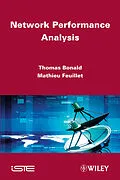The book presents some key mathematical tools for the performance
analysis of communication networks and computer systems.
Communication networks and computer systems have become extremely
complex. The statistical resource sharing induced by the random
behavior of users and the underlying protocols and algorithms may
affect Quality of Service.
This book introduces the main results of queuing theory that are
useful for analyzing the performance of these systems. These
mathematical tools are key to the development of robust
dimensioning rules and engineering methods. A number of examples
illustrate their practical interest.
Autorentext
Thomas Bonald joined Telecom ParisTech in 2009 after 10 years at France Telecom research labs. He is an Associate Editor of IEEE/ACM Transactions on Networking and Queuing Systems. His research focuses on the design and performance evaluation of traffic control algorithms for communication networks.
Mathieu Feuillet is currently a PhD candidate at INRIA. His research focuses on the stochastic modeling of some large distributed systems.
Zusammenfassung
The book presents some key mathematical tools for the performance analysis of communication networks and computer systems.
Communication networks and computer systems have become extremely complex. The statistical resource sharing induced by the random behavior of users and the underlying protocols and algorithms may affect Quality of Service.
This book introduces the main results of queuing theory that are useful for analyzing the performance of these systems. These mathematical tools are key to the development of robust dimensioning rules and engineering methods. A number of examples illustrate their practical interest.
Inhalt
Preface xi
Chapter 1. Introduction 1
1.1. Motivation 1
1.2. Networks 2
1.3. Traffic 3
1.4. Queues 5
1.5. Structure of the book 5
1.6. Bibliography 6
Chapter 2. Exponential Distribution 9
2.1. Definition 9
2.2. Discrete analog 10
2.3. An amnesic distribution 12
2.4. Minimum of exponential variables 13
2.5. Sum of exponential variables 15
2.6. Random sum of exponential variables 16
2.7. A limiting distribution 16
2.8. A very random variable 17
2.9. Exercises 18
2.10. Solution to the exercises 20
Chapter 3. Poisson Processes 23
3.1. Definition 23
3.2. Discrete analog 25
3.3. An amnesic process 27
3.4. Distribution of the points of a Poisson process 27
3.5. Superposition of Poisson processes 28
3.6. Subdivision of a Poisson process 29
3.7. A limiting process 30
3.8. A very random process 30
3.9. Exercises 31
3.10. Solution to the exercises 32
Chapter 4. Markov Chains 35
4.1. Definition 36
4.2. Transition probabilities 36
4.3. Periodicity 37
4.4. Balance equations 38
4.5. Stationary measure 38
4.6. Stability and ergodicity 39
4.7. Finite state space 40
4.8. Recurrence and transience 41
4.9. Frequency of transition 42
4.10. Formula of conditional transitions 43
4.11. Chain in reverse time 43
4.12. Reversibility 44
4.13. Kolmogorov's criterion 46
4.14. Truncation of a Markov chain 47
4.15. Random walk 49
4.16. Exercises 51
4.17. Solution to the exercises 52
Chapter 5. Markov Processes 57
5.1. Definition 57
5.2. Transition rates 58
5.3. Discrete analog 59
5.4. Balance equations 60
5.5. Stationary measure 61
5.6. Stability and ergodicity 61
5.7. Recurrence and transience 63
5.8. Frequency of transition 63
5.9. Virtual transitions 64
5.10. Embedded chain 66
5.11. Formula of conditional transitions 68
5.12. Process in reverse time 68
5.13. Reversibility 70
5.14. Kolmogorov's criterion 70
5.15. Truncation of a reversible process 71
5.16. Product of independent Markov processes 73
5.17. Birthdeath processes 74
5.18. Exercises 74
5.19. Solution to the exercises 78
Chapter 6. Queues 87
6.1. Kendall's notation 87
6.2. Traffic and load 88
6.3. Service discipline 90
6.4. Basic queues 91
6.5. A general queue 97
6.6. Little's formula 99
6.7. PASTA property 101
6.8. Insensitivity 101
6.9. PollaczekKhinchin's formula 102
6.10. The observer paradox 105
6.11. Exercises 108
6.12. Solution to the exercises 111
Chapter 7. Queuing Networks 119
7.1. Jackson networks 119
7.2. Traffic equations 120
7.3. Stationary distribution 122
7.4. MUSTA property 124
7.5. Closed networks 125
7.6. Whittle networks 127
7.7. Kelly networks 129
7.8. Exercises 131
7.9. Solution to the exercises 133
Chapter 8. Circuit Traffic 141
8.1. Erlang's model 141
8.2. Erlang's formula 142
8.3. Engset's formula 145
8.4. Erlang's waiting formula 149
8.5. The multiclass Erlang model 151
8.6. KaufmanRoberts formula 154
8.7. Network models 155
8.8. Decoupling approximation 157
8.9. Exercises 157
8.10. S...
